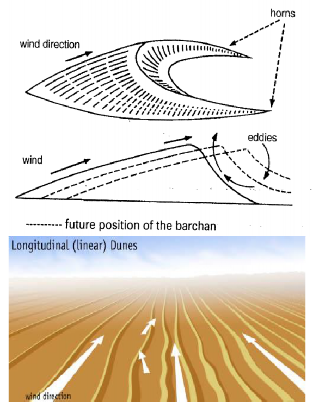10.3. Depositional Landforms-wind
The main depositional landforms of wind are sand dunes and loess.
Ripple Marks: Ripple marks are small scale depositional features of sand. This pattern is produced in unconsolidated sediments by the agents of erosion-like wind. Ripples may be either longitudinal or transverse.
Sand Dunes: These are mounds or ridges of wind-blown sand. The dunes are generally mobile.
There is wide variation in their shape, size and structure. On an average, their height ranges between a few metres to 20 metres, but there are some sand dunes which are more than several hundred metres in height and 5 to 6 km in length. Dunes are most well represented in the erg desert (a broad, flat area of desert).
There are many types of sand dunes. The two most important dunes are Barchans and
Longitudinal dunes, which are described in detail.
Barchans: They are crescent-shaped sand dune produced by the action of wind predominately from one direction. This type of dune possesses two "horns" that face downwind, with the steeper slope known as the slip face, facing away from the wind. They gradually migrate with the wind as a result of erosion on the windward side and deposition on the leeward side.

Longitudinal Dunes (Seif): Seif is an Arabic word, meaning sword dune. These are long, straight dunes and are parallel to the wind direction. Formed in regions where wind blows from more than one direction in a region with an abundant supply of sand.
